The Ram 2500 represents the end of an era in which farmers, construction workers, and even suburbanites could shift their own gears in a brand-new full-size pickup. That’s right, the Cummins diesel-powered heavy-duty Ram was the U.S.’s final full-size truck with a manual transmission, and after having driven it, I can say: My god are we now deprived.
When I set out to buy a classic pickup years ago, I wanted three things: a practical bench seat, a smooth and torquey inline-six motor, and a fun manual transmission. These desirable attributes, once common among American trucks, have been disappearing at an alarming rate. But my friend Michael Douglas, an engineer at Fiat Chrysler, owns a modern truck with all three.
In some ways, it truly is the holy grail. This is a 2017 Ram 2500 Laramie Sport Mega Cab outfitted with the optional 6.7-liter Cummins inline-six rated at 350 horsepower and 660 lb-ft of torque at a low 1,400 RPM (that’s 20 horsepower and 140 lb-ft fewer than the automatic model, in case you’re curious).

Michael’s previous vehicle was a Hemi V8-powered 2012 Ram 1500, but since the Michigander installed enormous one-ton axles on his Jeep XJ off-road rig (which sits on 39.5-inch Super Swamper tires shown above), he decided to upgrade his truck and trailer to handle the extra load. Though he was tempted to save roughly $9,000 by opting for the 6.4-liter gas V8, he couldn’t resist the lure of the Cummins. He’s been a fan of the Columbus, Indiana-based engine manufacturer for years (he owns a 1993 Dodge D250 4x2 regular cab long-bed with a 5.9-liter Cummins), and he recognizes how much of an advantage compression ignition engines are for towing applications.
As for choosing the manual, Michael’s status as a Fiat Chrysler employee meant he had the inside scoop on that Daimler-sourced G56 six-speed transmission’s fate: It was to be phased out of the Ram 2500 and 3500 after the 2018 model year. “Either do it now or forever be left guessing what a new manual Cummins is like,” Michael told me of his thought process just prior to pulling the trigger on his roughly $60,000 brute.
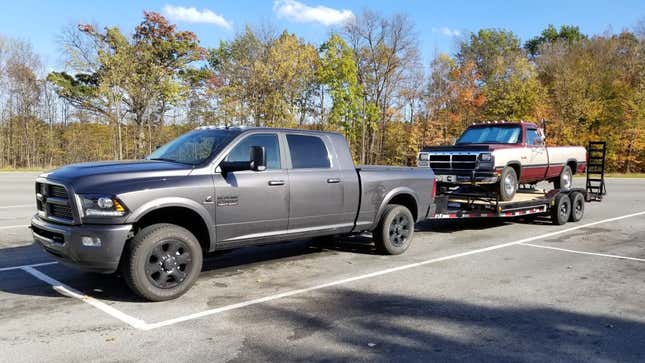
I met Michael at his farmhouse in rural parts of southeast Michigan after having arranged to drive his beloved machine (which has 50,000 miles on it) on the surrounding country roads. With his keys in my hand, I grabbed the handle on the truck’s A-pillar, and pulled myself up into the giant 2500 Ram, plopping down on a nice, wide leather bucket seat located what felt like a mile above the road surface.
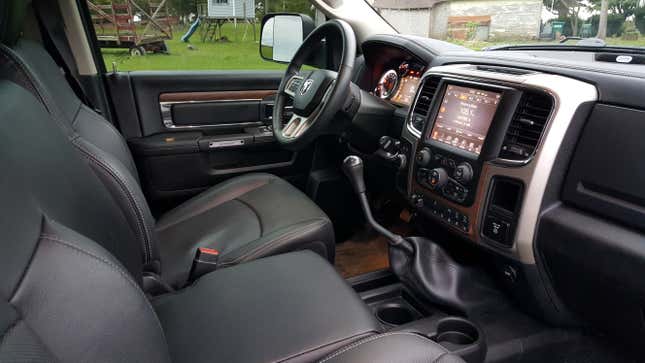
Once in that seat—directly adjacent to a flat center seat that doubles as an armrest, (I’d imagine that would be a tricky place to sit, since it requires straddling the shifter and placing your feet on a plastic floor console)—I shoved the chintzy DaimlerChrysler-era key into the dashboard and turned it to the “on” position. After under 10 seconds of waiting for the grid heater to warm up on the 62-degree Fahrenheit afternoon, I clutched in and cranked the motor over.
My door was open and the foot brake was engaged, as I wanted to take some pictures of the truck as the Cummins warmed up. From the outside, the motor sounded amazing—agricultural in some ways, with a classic diesel-y rattle, but also authoritative in a big rig-esque sort of way. Closing the door hushed the sound markedly, leaving me in a decently high-quality, reasonably quiet cabin with absurd amounts of space in every direction.
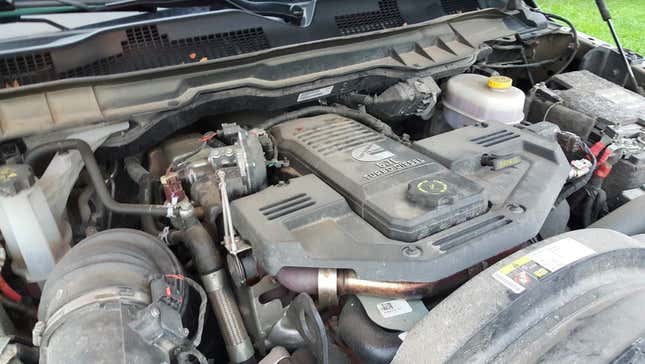
I pulled the park brake release handle on the left side of the lower dash near the driver’s footwell, shoved the tall, bent shifter to the left and up, and slowly let off the clutch.
I realized quickly that I could have lifted off that clutch with a lot less finesse because first gear on this truck is absurdly short. With a nearly six-to-one ratio, it is in every way a true “granny gear” that—with the 3.42 axle ratio and 33-inch-ish tires—runs the motor to its peak power RPM of 2,800 revs by about 15 MPH.
While I bet that first gear is a godsend for preserving clutch life while towing, for daily driving, I found it best to start in second gear, which offers a Typical For A First Gear In A Manual Gearbox 3.28-to-one ratio.
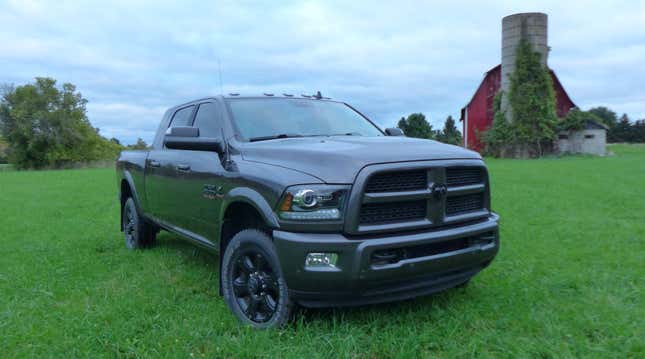
From second, I clutched in and gripped the shifter—a satisfyingly visceral stick through which I could feel the truck’s heartbeat—and slid it up, right, and up again into third. Pressing the accelerator pedal hard in that gear sent an avalanche of torque through the drivetrain as boost kicked in.
My pedal’s position near the floorboard meant what was normally a smooth engine during steady state cruising stopped trying to hide its diesel-y nature, and roared with an intimidating fury. The ~8,200-pound machine wasn’t quick, of course, but with the rightmost pedal mashed, it felt like it was going to accelerate wherever the front wheels were pointed, and there was nothing anyone could do about it.

With my third gear pull out of the way, shifting to fourth, then fifth, then sixth revealed that this motor can usually lug the truck along at the desired speed at low, sub-1,200 RPM engine speeds without any problems. Choosing high gears sacrifices some acceleration, of course, but the motor felt happy handling the loads even at the low revs, and from a stop—even starting in second—it felt borderline un-stallable.
The low-end torque is fantastic.

With Michael in the passenger seat, I left his rural neighborhood and headed into suburbia, where I noted a vague but nicely boosted hydraulic power steering feel as well as a decent ride—surprising for a heavy duty truck with two solid axles. Those axles are coil sprung, with the front incorporating a three-link setup with two radius arms and a track bar, while the rear is a five-link with a pair of both upper and lower control arms and a track bar.
The truck felt a bit bouncy over bumps, but that’s not surprising for an unloaded heavy duty truck. I thought it was acceptable given the machine’s intended function. Ditto for wind noise and just general cabin comfort. This Ram 2500 is totally daily drivable, and that’s exactly what Michael does.
Though the truck’s hood is at the same level of many small homes, the seat sits at water tower-height, so visibility out of the front is excellent. The view out of the rearview mirror isn’t great thanks in part to the rear fixed center headrest, but the massive fold-out tow mirrors help on that front.
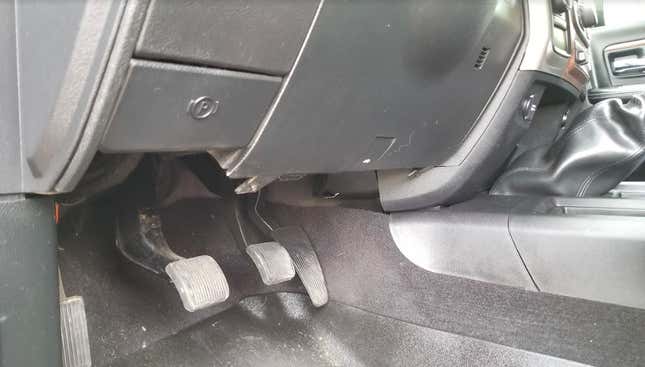
One thing I thought was a bit odd was the clutch pedal. As I pressed it, I felt a vibration through my left leg and heard what seemed like a rubbing noise of some sort. I also found that, since I like to drive close to the dashboard, and since I’m still waiting for my growth spurt to arrive, my left shin made contact with the lower dash anytime I applied the clutch. It was a tiny bit uncomfortable.
My three-point turnaround attempt, after driving the truck again a few days later, and accidentally overshooting Michael’s driveway was also a bit awkward. Though I liked using the “crash through” reverse gear (shifter pulled hard to the left and down). This Ram is just a big, sometimes cumbersome truck, and while the visibility from the rearview mirror isn’t great, the backup camera and side mirrors help make navigating this Goliath significantly less stressful.

After pulling off the three-point turn without flattening any mailboxes or getting stuck in a ditch, I rolled up to Michael’s house on Saturday, popped the transmission into neutral, stepped on the park brake, and shut the vehicle down. The shifter shook violently from side-to-side as the motor’s revs slowed to a halt, and within moments all the glorious diesel clatter was gone.
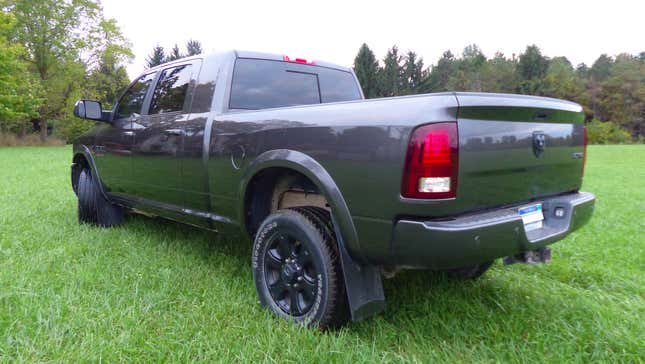
As I shifted through my Jeep J10’s four-speed on my way home, I couldn’t help but mourn the end of the manual full-size pickup truck era. I couldn’t shake Michael’s Ram 2500 from my mind; even after that short drive, I knew I’d just driven something special. Its incredible low-end torque, its awesome bench seat surrounded by a decent interior, its handsome looks, its livable ride quality, and above all, its lovely long-throw shifter—all of these things had combined to form one of the greatest pickups I’d ever driven.
It’s no wonder Michael plans to keep this thing until he’s an old man. It is, after all, the holy grail.
